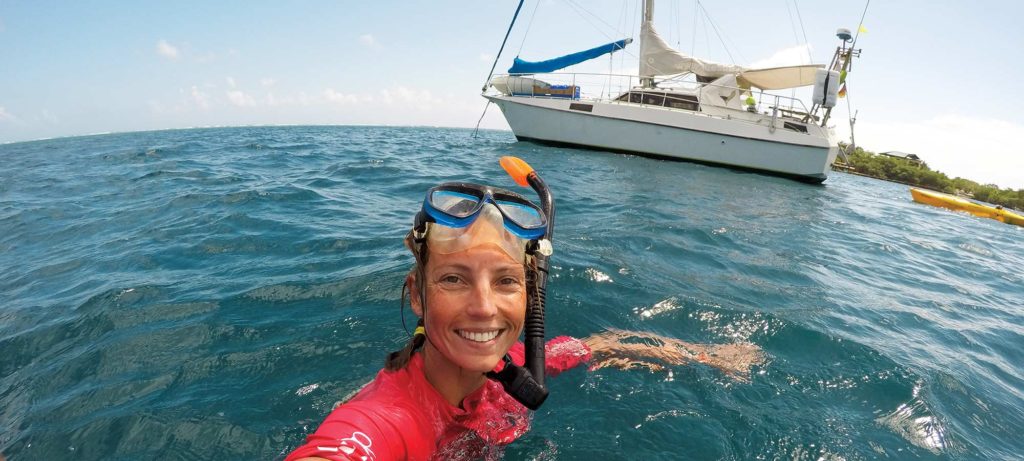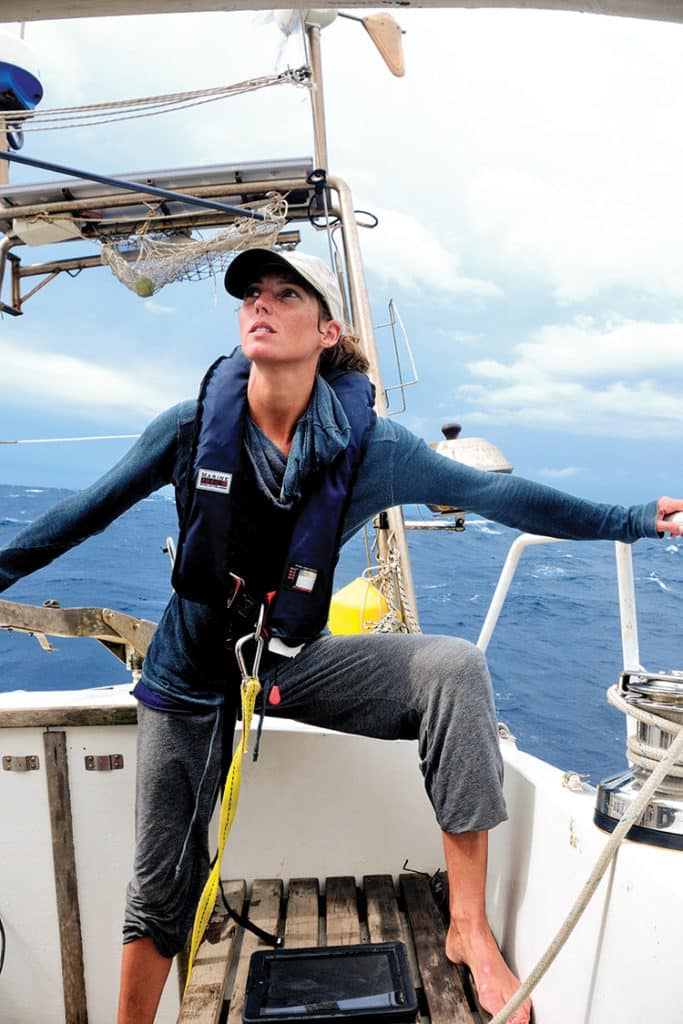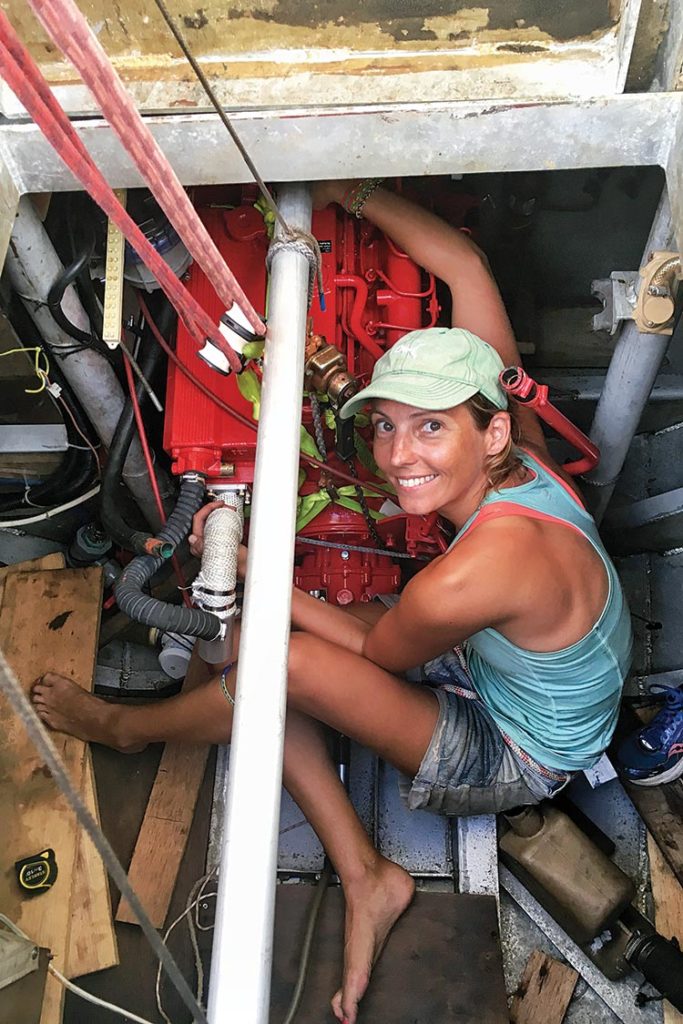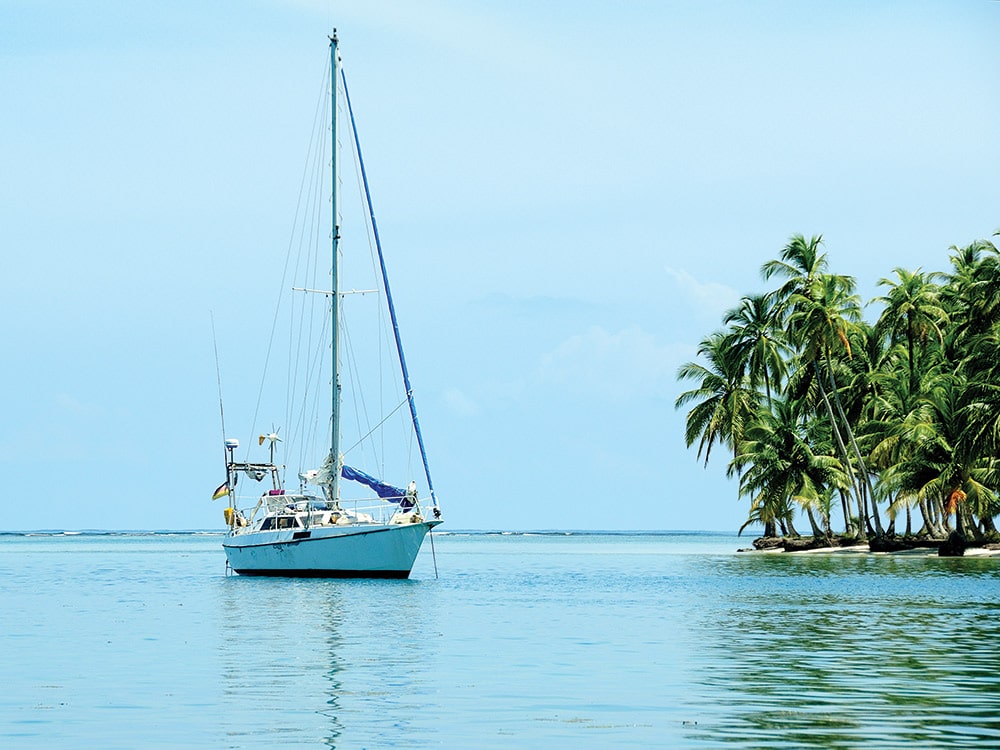
Very few of us are brave enough to jump into the deep end of our wildest dreams, throw off our self-doubt and muster the courage to just do it. Nike Steiger is one of the few. Toiling away at her day job in Hamburg, Germany, Nike (pronounced nee-kay) had a dream of conquering one of her personal goals by sailing off into the sunset. The problem wasn’t her inexperience as a sailor or that she knew very little about the cruising lifestyle, it was simply that she didn’t have her own boat. That she would be untying the lines alone never entered into the equation. She searched for several years before finding Karl in Colón, Panama. The seller had informed her that the vessel had been left unattended for five years, but Nike was still surprised by the “forest of mold” covering the cabin that was so toxic she had to don a hazmat mask just to go below deck. She hadn’t signed the bill of sale yet, but at the agreed price of 8,000 euros, even a little toxic mold wasn’t going to deter her. With the help of a local mechanic, she got the engine to turn over, and her dream of sailing the world was once again revved up.
“I wanted to see what was out there, test myself and finally start what I had been fighting for.”
It would be almost a year, and another 25,000 euros, before she left the dock, but Nike says, “I will never forget that moment, when I took out Karl for the very first spin inside the breakwaters of Colón, being the captain of my own sailing vessel.”
More than three years later, not only has Nike figured out the cruising lifestyle but she’s a successful video blogger, or “vlogger.” The third season of her video-blog series Untie the Lines is now on YouTube. She describes it as “the story about the ups and downs of buying, refitting and living on a boat, and of course sailing singlehanded. All of that on a rather small budget and with not a lot of previous knowledge, but with heaps of enthusiasm and quite a bit of endurance.”
Since we are sailing on opposite sides of the world, I caught up with Nike online, where we talked vlogging and swapped sailing stories. I found her enthusiasm contagious, and her insights on sailing and maintaining a boat singlehanded inspiring.
Heather Francis: Did you have much sailing experience before you decided to embark on your sailing adventure?
Nike Steiger: Not a lot, around 2,000 nautical miles. Those miles were coastal sailing, with some overnights but no multiday passages nor big ocean crossings. I had never singlehanded a boat before in my life — well, except an Optimist; does that count? But I did go sailing twice with the stepfather of one of my best friends, and he let me pretend I was singlehanding his boat while he was on board. That was on a pretty Hallberg-Rassy 35.
**HF: Can you tell me a little about your boat and why you decided to name it Karl?
NS: Karl is a Reinke Super 10, built in 1992 from aluminum. He is a tough boy, sturdy as a tank, and I love him with all my heart. He surely has not been built for racing, but with his twin keels and therefore little draft, we can enter into many shallow bays and rivers.
For some reason, I wanted my boat to be a male companion. I was looking for a short and easy name, and Karl was always a name I have liked. Karl is derived from the old German word karal, which means “husband” but also “the free one” — the perfect partner for me to sail the world.

HF: Eight months after you bought your boat, you found several holes in Karl’s aluminum hull. You had to weigh your options: sell up, as people were encouraging you to do, or invest more money and sail on. Why did you decide to continue?
NS: At the point when I found the holes in my hull it was actually the time when I was finally supposed to set sail and become a cruiser, not just a boat fixer. That is why I think that moment of finding the holes was an even bigger shock than if it had happened in the beginning.
One night, I sat next to Karl, and I looked at the moon and asked myself if I should give in, admit that I had taken too big of a bite and that I was just not able to pull this whole journey off. And the answer that I found inside myself was so clear: I wanted to go sailing. I wanted to see what was out there, test myself and finally start what I had been fighting for during the past half year.
I made a decision that the boat there next to me was the right one, and I believed in Karl and his general strength. And I believed that if I just truly wanted this journey to happen that I would find a way and the energy to get out of this situation, come what may. Seems I was right after all.
HF: After transiting the Panama Canal in 2016, you ran into major problems again, forcing you to delay sailing to the South Pacific.
NS: Yes, engine troubles. The timing belt that moves the camshaft slipped, and the pistons smashed into the valves and cracked the cylinder head where the valves sit. One could open the engine up and rebuild it. But this would cost quite a bit of money, and time too. Since I am still dreaming of sailing a bit farther away from the mainland with all its supplies, I decided to invest in a new engine. I was able to work with Beta Marine and recently installed a new Beta 43. There were many things that were new for me in this re-power project. It was super interesting, but also at times tiring and scary. But the moment of firing Big Red up for the first time blew away all the stress and worry and gave way to pure excitement and happiness.
HF: When sailing alone, you really get to know your true self, your strengths and weaknesses. What have you learned about yourself?
NS: On the one hand, I have learned that I carry way more fears inside myself than I had thought. When I went sailing before I owned my own boat, I never felt seasick — OK, once, but not really badly — and I was never really afraid. I cannot recall thinking, Oh my god, we are going to capsize, or Hmm, I wonder if maybe we might sink, or Will I be fast enough to do this task if something happens all of a sudden. The nights I spent at anchor with my family on vacation, I just slept peacefully; now that never happens since buying Karl. So, yes, I had to admit to myself that I was not as fearless as I had assumed I was.
But on the other hand, I have also been assured that I can trust my physical and emotional strength when times get rough. Even if I have anxieties before departure or during a passage, when something does happen, I have always found a way out without seriously hurting myself or my boat.

HF: What difficulties or obstacles have you faced as a female singlehander?
NS: I get annoyed when I am not strong enough to loosen something or to carry something. But I have learned some little tricks and life hacks to make up for my lack of strength.
I was nervous at first to ask someone to lend me a hand, because I didn’t want to seem like the typical stereotype of a woman needing help from a man because she isn’t strong enough. I have to say, though, that the men I have asked for help have not been disrespectful in those situations, but usually rather impressed that I was trying to go for it anyway.
In addition to the typical surprise — “Oh, you are alone on your boat?” — comes the astonishment that I also do most of my work by myself. This is then usually followed by the “Don’t you feel lonely/scared/vulnerable all by yourself?”
And yes, sometimes I do feel vulnerable. I try not to let it overtake me too much because I think the more you think and worry about it, the more likely it is something might happen to you.
HF: I admire you and other women who sail singlehanded, who are willing to get dirty and work on their boat. You make the Untie the Lines videos as a way to inspire others to chase their dreams and to conquer their self-doubts. Who are some of your inspirations?
NS: Wow, there are many great books, blogs and videos out there — it’s hard to keep the list short. One of the first books that inspired me was Dove by Robin Lee Graham, and I also enjoyed Tania Aebi’s book Maiden Voyage a lot.
It’s a big dream of mine to head to Alaska one day, which is why I enjoy the great videos of Yacht Teleport and S/Y Zero. One of my new favorites is that French sailor Guirec Soudée, who just did the Northwest Passage on his wicked aluminum sloop with his chicken, Monique.
Someone who always inspires me to learn new skills and dare to trust more in myself is my friend Maria LaPointe. She is an awesome sailor and great mechanic, welder and rigger, and she is the one who kept me going when I had doubts that I was not strong or good enough to be out here by myself.

HF: Making a video blog is more work than people think. You work with a professional videographer, Patrice Lange, on Untie the Lines, sending hard drives of footage back to Germany every few months for editing. Did you know each other before you started the project?
NS: I didn’t know anything about filming or editing when I started my journey. Patrice was convinced that we should give it a try, and we did not really have anything to lose. I worked with Patrice when I was still working back in Hamburg. I was running the marketing department of a medium-size company, and we had contracted him for some product shots and videos.
During the second season of Untie the Lines, I filmed so much more that it was too much work for Patrice by himself to browse through the material. That is why Daniel Dohlus joined our team and does the pre-editing before Patrice gives the episodes the final touch.
HF: Untie the Lines is into its third season. What is in store for us next?
We released a full-length documentary in January titled Untie the Lines: A Journey of Salt, Sweat and Determination. It’s about the first part of my journey, the circumnavigation of the western Caribbean, and the previous/ongoing refit, of course.
It is a mix of footage that was already published, and interviews and material that were not released yet. The movie is another step up in terms of professionalism — for example, extra color grading and such. We wanted it to have a slightly more cinematic touch to it.
Money-wise, we decided to go for private investors that will provide the money for the production and be paid back, step by step, once the movie starts selling.
HF: Video blogging has gained popularity in the past few years. Do you have any advice for new vloggers?
NS: In my opinion, it helps if you start vlogging because you really want to put something out there for some other reason than purely for making money with it. Start with putting some videos out there, see how people react, ask for feedback, watch your numbers for a while and see how you deal with the extra workload while you travel and if you feel OK with it. Give yourself some time to get in your groove, to improve yourself and to build an audience.
Now, once you have done that for a while, if you decide to keep going and have a feeling that your fan base might like to support your work, give them the opportunity to do so.
For me, it is important that people understand that they are paying for something that I produce. I make videos, people consume them and pay for them, even if it is voluntarily. Crowdfunding is a sensitive topic — lots of people call it e-begging — which is why it is important to me that my documentary is seen as a business, not that I am collecting donations just so I can live my dream. If I come to a point where I cannot afford to live the way I do with the work I do, I need to come up with something different to get some extra cash or to improve my business model.
HF: When you set out to untie the lines, you estimated you would be sailing for three years. Now that you’ve surpassed your three-year projected timeline, what are your future plans?
NS: I untied the lines to sail the world, not to circumnavigate. In my dreams, I will sail to French Polynesia, and from there, I would love to head north to Hawaii and then Alaska. If I ever get there, I will be the happiest person ever. Untie the Lines will continue. It has been such a comfort to have all these great people traveling along with me; I don’t think I would want to miss that.
You can follow Nike’s adventure on her YouTube channel WhiteSpotPirates, at whitespotpirates.com, on Facebook and on Instagram @whitespotpirates.








